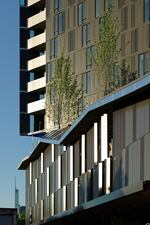
Yard rises 200 feet into Portland's skyline. By comparison, it's about half the size of better known skyscrapers, but the lack of competing structures on the east side accentuates its form.
Courtesy of Wes Pope
Not since Big Pink or the Interstate Bank tower has Portland produced a high-rise that so many people have opinions about. We’re talking about Yard, the chocolate-brown, 21-story apartment tower recently finished at the east end of the Burnside Bridgehead.
The many reactions are not so much about its height as they are about its prominence. It looms large and is seen from every direction, especially from the west bank of the Willamette River. It fills the view in both directions on Portland's main thoroughfare: Burnside Street. As a friend of mine put it, “I keep thinking the bridge is up.”
Yard has also been in the news for other reasons. After Portland’s Design Commission approved the building, the architect and developer team, Skylab and Key Development, removed dozens of windows to meet the energy code. The architects did nothing wrong. But city inspectors missed the change, which would have sent it back to design review. Sixty-seven windows are now being added. The city and developer are splitting the cost.
So what about the architecture?
Yard is one of the most complicated high-rises ever built in Portland. One side of its site is 40 feet lower than the other. It's foundations straddle Portland's Big Pipe. Its south-side butts up against the Burnside Bridge and the Burnside Skate Park, one of Portland's most renowned counterculture landmarks. When the building formally opens in a few weeks, there will be an 8,000-square-foot spa, a 4,000-square-foot gym, two restaurants, two bars, parking for cars and a locker for bikes all interwoven on its four levels. About 60 of its units are subsidized for workforce housing — 60 percent of median rents.
There is nothing quite like Yard.
Why did the designers shape it this way? We spoke with the architect, Jeff Kovel, about what drove the form of the building. He's worked on a diverse range of projects, including the Doug Fir Lounge and the expansion of Nike's world headquarters.

Architect Jeff Kovel says of Yard’s window wall system, “We worked to really integrate the ventilation, elevate the details of the system. The grid in the patters is really unique to Portland and this system."
Courtesy of Wes Pope
Kovel notes, "The big pipe project runs down diagonally under this site, so I'd say maybe 40 percent of this site was unbuildable for anything over five or six stories. That had a big impact in the engineering for the tall building foundations."
Many of the critics of the building talk about the darkness of it, but Kovel says, "I would actually prefer the building to be darker, to be honest with you. At the predesign review we were encouraged to lighten it up. I don't have an issue with the color that it is, but it's interesting that a number of the other buildings in the neighborhood have actually became the same color — that wasn't intentional."
The idea, Kovel says, was that Yard's heavier form would then start to dissolve at the top with the reflectivity of the evening light and other lighting conditions.
Yard has been controversial for how many windows it has. But what's far more interesting is the type of windows. Last week, we looked at several new west side towers that use expensive curtain glass window systems. The Yard's windows are much, much cheaper — partly because a building of this scale and on this location is riskier. Every new building is a bet that the rents will exceed costs. This building was started eight years ago when rents were not what they are today
Kovel tells us, "All of the towers in Vancouver are using it, Toronto. It's generally a product that is visually kind of banal; it's not something that you get super excited about. When we learned that we had to use it we were kind of exciting for the opportunity to use it and innovate with something that hadn't really been innovated with. We started working with the manufacture to design custom venting, to work on essentially taking a run of the mill system and elevating it to a higher quality of design and detail. I think if you were to look at this building in a portfolio of buildings using this system it would really stand out as one of the premier examples of what you can do with this system, so I'm really proud of that aspect of it."

Jeff Kovel: "Part of this was about opening up the podium terrace roof to the public so that this was a destination for all of Portland and inviting the city into kind of the backyard for these tenants.”
Wes Pope / Courtesy of Wes Pope
Traditionally, Portland's architecture here has been fairly conservative. But Yard may be part of a whole new generation interesting, dynamic buildings.
Yard is likely to fill quickly. But it's a risky building in that access to the lower floors — to the restaurants, bars, spa and terrace — is complicated. There's not much retail around, and it will be years before more is likely to crop up. Will the experiment succeed? Will it be a vibrant addition to the city?
Portlanders may eventually appreciate this building, especially when more conventional buildings rise next to it — like the 200-foot tower just announced on the other side of the bridge. Let's meet back at the Yard in 10 years and then judge.